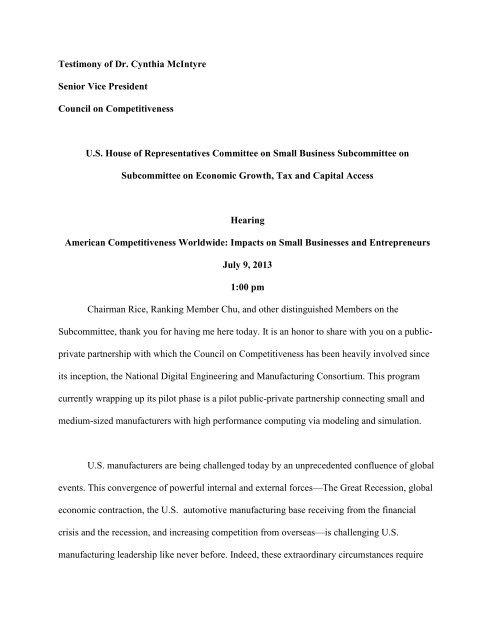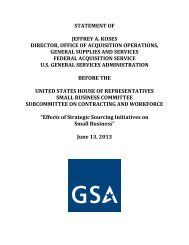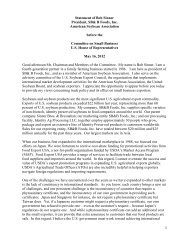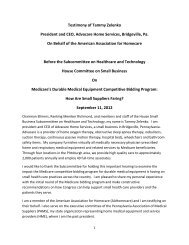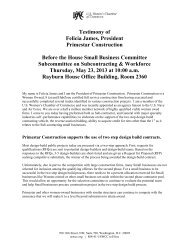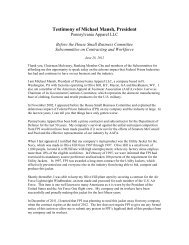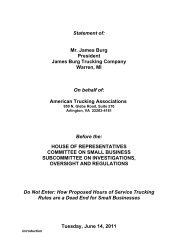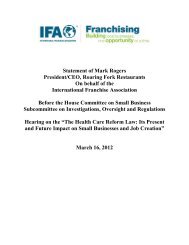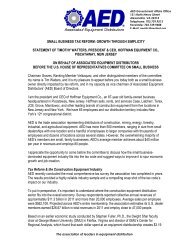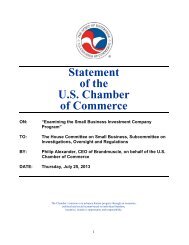Testimony of Dr. Cynthia McIntyre Senior Vice President Council on ...
Testimony of Dr. Cynthia McIntyre Senior Vice President Council on ...
Testimony of Dr. Cynthia McIntyre Senior Vice President Council on ...
You also want an ePaper? Increase the reach of your titles
YUMPU automatically turns print PDFs into web optimized ePapers that Google loves.
<str<strong>on</strong>g>Testim<strong>on</strong>y</str<strong>on</strong>g> <str<strong>on</strong>g>of</str<strong>on</strong>g> <str<strong>on</strong>g>Dr</str<strong>on</strong>g>. <str<strong>on</strong>g>Cynthia</str<strong>on</strong>g> <str<strong>on</strong>g>McIntyre</str<strong>on</strong>g><br />
<str<strong>on</strong>g>Senior</str<strong>on</strong>g> <str<strong>on</strong>g>Vice</str<strong>on</strong>g> <str<strong>on</strong>g>President</str<strong>on</strong>g><br />
<str<strong>on</strong>g>Council</str<strong>on</strong>g> <strong>on</strong> Competitiveness<br />
U.S. House <str<strong>on</strong>g>of</str<strong>on</strong>g> Representatives Committee <strong>on</strong> Small Business Subcommittee <strong>on</strong><br />
Subcommittee <strong>on</strong> Ec<strong>on</strong>omic Growth, Tax and Capital Access<br />
Hearing<br />
American Competitiveness Worldwide: Impacts <strong>on</strong> Small Businesses and Entrepreneurs<br />
July 9, 2013<br />
1:00 pm<br />
Chairman Rice, Ranking Member Chu, and other distinguished Members <strong>on</strong> the<br />
Subcommittee, thank you for having me here today. It is an h<strong>on</strong>or to share with you <strong>on</strong> a publicprivate<br />
partnership with which the <str<strong>on</strong>g>Council</str<strong>on</strong>g> <strong>on</strong> Competitiveness has been heavily involved since<br />
its incepti<strong>on</strong>, the Nati<strong>on</strong>al Digital Engineering and Manufacturing C<strong>on</strong>sortium. This program<br />
currently wrapping up its pilot phase is a pilot public-private partnership c<strong>on</strong>necting small and<br />
medium-sized manufacturers with high performance computing via modeling and simulati<strong>on</strong>.<br />
U.S. manufacturers are being challenged today by an unprecedented c<strong>on</strong>fluence <str<strong>on</strong>g>of</str<strong>on</strong>g> global<br />
events. This c<strong>on</strong>vergence <str<strong>on</strong>g>of</str<strong>on</strong>g> powerful internal and external forces—The Great Recessi<strong>on</strong>, global<br />
ec<strong>on</strong>omic c<strong>on</strong>tracti<strong>on</strong>, the U.S. automotive manufacturing base receiving from the financial<br />
crisis and the recessi<strong>on</strong>, and increasing competiti<strong>on</strong> from overseas—is challenging U.S.<br />
manufacturing leadership like never before. Indeed, these extraordinary circumstances require
extraordinary measures, and the U.S. public and private sectors must cooperate strategically,<br />
coordinating and investing to repair, repositi<strong>on</strong>, and reaffirm U.S. global leadership in<br />
manufacturing.<br />
Research by the <str<strong>on</strong>g>Council</str<strong>on</strong>g> <strong>on</strong> Competitiveness presents powerful evidence <str<strong>on</strong>g>of</str<strong>on</strong>g> the capacity<br />
<str<strong>on</strong>g>of</str<strong>on</strong>g> high performance computing (HPC) to drive innovati<strong>on</strong> and make U.S. companies and the<br />
nati<strong>on</strong> more competitive. Indeed, for those who have adopted it, HPC represents a crucial edge<br />
that can build and sustain competitive advantage through innovative product design, producti<strong>on</strong><br />
techniques, cost savings, improved time-to-market cycles, and overall quality. However, <str<strong>on</strong>g>Council</str<strong>on</strong>g><br />
research has also shown that many U.S. companies are “stuck at the desktop” and not able to<br />
take full advantage <str<strong>on</strong>g>of</str<strong>on</strong>g> HPC, while still others—including many suppliers to U.S. tier 1<br />
companies—have limited, if any, computati<strong>on</strong>al R&D capacity (with many not even using<br />
desktop workstati<strong>on</strong>s).<br />
Our situati<strong>on</strong> becomes even more critical when <strong>on</strong>e surveys the competitive landscape<br />
that U.S. companies face today—where many foreign governments have established publicprivate<br />
partnerships for the use <str<strong>on</strong>g>of</str<strong>on</strong>g> HPC in manufacturing. Indeed, sustained nati<strong>on</strong>al investments<br />
in innovati<strong>on</strong> and manufacturing are occurring in China (e.g., China’s 863 Program), the<br />
European Uni<strong>on</strong> (PRACE program), and in the UK to name <strong>on</strong>ly a few. Meanwhile, our own<br />
nati<strong>on</strong>al policy regarding HPC is fragmented. The time is right for the U.S. federal government<br />
to take bold steps to leverage HPC for next-generati<strong>on</strong> innovati<strong>on</strong>, manufacturing, and U.S.<br />
competitiveness.
The <str<strong>on</strong>g>Council</str<strong>on</strong>g> sees public-private sector collaborati<strong>on</strong> as the best and most effective means<br />
for quickly advancing HPC in manufacturing. However, to be successful in this effort, much<br />
closer coordinati<strong>on</strong> between government, nati<strong>on</strong>al labs, universities, and industry will be needed<br />
and must be bolstered by a nati<strong>on</strong>al strategy that transcends the parochial interests <str<strong>on</strong>g>of</str<strong>on</strong>g> any single<br />
federal agency, department, university, or HPC center. To these ends, the <str<strong>on</strong>g>Council</str<strong>on</strong>g> <str<strong>on</strong>g>of</str<strong>on</strong>g>fered several<br />
recommendati<strong>on</strong>s for quick acti<strong>on</strong>:<br />
<br />
Improve coordinati<strong>on</strong> <str<strong>on</strong>g>of</str<strong>on</strong>g> the federal government’s overall approach to advancing HPC (i.e.,<br />
work toward a more balanced program across DOE labs, NSF-funded supercomputing<br />
centers, the DOD, universities, and so <strong>on</strong>).<br />
<br />
Increase outreach efforts to chief executives (the so-called “C-suite”) in manufacturing to<br />
help them better understand the true benefits <str<strong>on</strong>g>of</str<strong>on</strong>g> HPC to their bottom lines. Bring together<br />
CEOs and CTOs from the nati<strong>on</strong>’s manufacturing base, al<strong>on</strong>g with U.S. experts in HPC<br />
hardware and s<str<strong>on</strong>g>of</str<strong>on</strong>g>tware, in a nati<strong>on</strong>al summit to better frame and address the issues<br />
surrounding HPC for next-generati<strong>on</strong> manufacturing.<br />
<br />
Enhance industrial access to HPC resources by establishing a government-supported HPC<br />
center or program dedicated solely to assisting U.S. industrial partners in addressing their<br />
research and innovati<strong>on</strong> needs by adopting or improving modeling, simulati<strong>on</strong>, and advanced<br />
computati<strong>on</strong>.<br />
o The center or program would provide assistance with problem definiti<strong>on</strong>; s<str<strong>on</strong>g>of</str<strong>on</strong>g>tware<br />
selecti<strong>on</strong>, development, or customizati<strong>on</strong> (indeed, s<str<strong>on</strong>g>of</str<strong>on</strong>g>tware is <str<strong>on</strong>g>of</str<strong>on</strong>g>ten the most crucial<br />
gap); and access to HPC hardware.<br />
o It should feature a task force or working group that would (1) visit all top U.S.<br />
manufacturing companies, HPC centers, nati<strong>on</strong>al labs, and major independent
s<str<strong>on</strong>g>of</str<strong>on</strong>g>tware vendors (ISVs); and (2) work to address major technical hurdles in the<br />
manufacturing sector’s use <str<strong>on</strong>g>of</str<strong>on</strong>g> HPC (e.g., s<str<strong>on</strong>g>of</str<strong>on</strong>g>tware, interoperability, multiphysics, and<br />
so <strong>on</strong>).<br />
o It should be overseen by an advisory board with balanced membership from<br />
government, university, and industry.<br />
o It could be started with initial funding from the federal government, but should be<br />
supported in the l<strong>on</strong>g term by a broad mixture <str<strong>on</strong>g>of</str<strong>on</strong>g> support from federal, university, and<br />
industrial partners.<br />
<br />
Invest in U.S. HPC expertise. Some <str<strong>on</strong>g>of</str<strong>on</strong>g> our most precious nati<strong>on</strong>al resources are the people<br />
who operate in the HPC domain—from the computati<strong>on</strong>al scientists and engineers to the<br />
domain experts that apply HPC in their fields (e.g. mechanical, electrical, chemical<br />
engineers). The federal government, nati<strong>on</strong>al labs, universities, and industry need to take<br />
c<strong>on</strong>crete steps to educate, train, retrain and retain people with the expertise to take advantage<br />
<str<strong>on</strong>g>of</str<strong>on</strong>g> large HPC systems and manage their applicati<strong>on</strong> and deployment in new settings, and<br />
create the new s<str<strong>on</strong>g>of</str<strong>on</strong>g>tware and hardware needed to drive innovati<strong>on</strong>.<br />
The <str<strong>on</strong>g>Council</str<strong>on</strong>g> <strong>on</strong> Competitiveness and selected original equipment manufacturers (OEMs)<br />
developed a Midwestern regi<strong>on</strong>al pilot program as a public-private partnership with the U.S.<br />
federal government based <strong>on</strong> these recommendati<strong>on</strong>s. The pilot program is aimed at improving<br />
competiveness and innovati<strong>on</strong> in small- and medium-size enterprises (SMEs) in the U.S.<br />
manufacturing supply chain. The ultimate outcome <str<strong>on</strong>g>of</str<strong>on</strong>g> the pilot program will be a workforce with<br />
enhanced technical skills, improved product quality, better customizati<strong>on</strong> <str<strong>on</strong>g>of</str<strong>on</strong>g> products, and job<br />
retenti<strong>on</strong> and growth.
On August 31, 2010, a Summit & Workshop was held at the Gleacher Center in Chicago that<br />
brought together representatives from a broad cross-secti<strong>on</strong> <str<strong>on</strong>g>of</str<strong>on</strong>g> industry, academia and the federal<br />
government to brainstorm ideas and to agree up<strong>on</strong> the necessary and desired comp<strong>on</strong>ents for<br />
such a pilot program. This document captures the decisi<strong>on</strong>s made at that meeting, and provides<br />
guidelines for implementing the pilot program.<br />
The high level goal <str<strong>on</strong>g>of</str<strong>on</strong>g> this pilot program is to develop and dem<strong>on</strong>strate a sustainable,<br />
scalable and replicable model for accelerating and broadening use <str<strong>on</strong>g>of</str<strong>on</strong>g> modeling, simulati<strong>on</strong> and<br />
analysis (MS&A) in Midwestern SMEs through a public-private partnership (described below).<br />
Funding will be provided as seed m<strong>on</strong>ey for this pilot program, with the expectati<strong>on</strong> that it will<br />
dem<strong>on</strong>strate a path toward l<strong>on</strong>g-term sustainability. This is <strong>on</strong>ly achievable if (a) the supply<br />
chain members can rapidly reach a point where the results produce cost-benefits that allow and<br />
incentivize them to c<strong>on</strong>tinue use <str<strong>on</strong>g>of</str<strong>on</strong>g> MS&A, either independently or within the c<strong>on</strong>tinued c<strong>on</strong>text<br />
<str<strong>on</strong>g>of</str<strong>on</strong>g> the pilot program, and (b) s<str<strong>on</strong>g>of</str<strong>on</strong>g>tware vendors can develop a business model that provides easier<br />
and more affordable access to s<str<strong>on</strong>g>of</str<strong>on</strong>g>tware tools for SMEs.<br />
The l<strong>on</strong>ger term goals <str<strong>on</strong>g>of</str<strong>on</strong>g> this pilot program are to put U.S. manufacturing <strong>on</strong> a path<br />
toward using MS&A for digital prototyping <str<strong>on</strong>g>of</str<strong>on</strong>g> new and existing products and for process<br />
manufacturing. Also, we expect this pilot program to be a dem<strong>on</strong>strati<strong>on</strong> <str<strong>on</strong>g>of</str<strong>on</strong>g> effective<br />
coordinati<strong>on</strong> that will be used in the startup <str<strong>on</strong>g>of</str<strong>on</strong>g> other regi<strong>on</strong>al centers.<br />
The current level <str<strong>on</strong>g>of</str<strong>on</strong>g> MS&A across the manufactures in the U.S. is greatly varied with the<br />
companies lying at <strong>on</strong>e <str<strong>on</strong>g>of</str<strong>on</strong>g> the three levels; entry, advancing, and expert. The key points are that<br />
U.S. manufacturers are at different levels in their adopti<strong>on</strong> <str<strong>on</strong>g>of</str<strong>on</strong>g> MS&A in their processes, and that<br />
a natural progressi<strong>on</strong> <str<strong>on</strong>g>of</str<strong>on</strong>g> adopti<strong>on</strong> and expertise exists to either adopt or advance usage to the next<br />
level. The focus <str<strong>on</strong>g>of</str<strong>on</strong>g> the pilot program is <strong>on</strong> the first two levels:
• Entry level—supply chain manufacturers who currently have no capabilities in MS&A,<br />
but recognize the benefits as a way to increase their competitive advantage.<br />
• Advancing—supply chain manufacturers who currently have some initial capability, but<br />
want to become more advanced in their use <str<strong>on</strong>g>of</str<strong>on</strong>g> MS&A to promote innovati<strong>on</strong> and ensure their<br />
l<strong>on</strong>g-term competitive advantage.<br />
This early pilot program laid the groundwork for the formal recogniti<strong>on</strong> <str<strong>on</strong>g>of</str<strong>on</strong>g> the pilot<br />
program as a partnership with the U.S government. In March 2011, a Memorandum <str<strong>on</strong>g>of</str<strong>on</strong>g><br />
Understanding was signed at a White House Cerem<strong>on</strong>y, formally establishing the public-private<br />
partnership (PPP) known as the Nati<strong>on</strong>al Digital Engineering and Manufacturing C<strong>on</strong>sortium<br />
(NDEMC) for five years. The <str<strong>on</strong>g>Council</str<strong>on</strong>g> <strong>on</strong> Competitiveness became the lead partner for the<br />
project, in collaborati<strong>on</strong> with a number <str<strong>on</strong>g>of</str<strong>on</strong>g> other stakeholders. The C<strong>on</strong>sortium is funded by a<br />
public-private partnership established by the United States Government and a number <str<strong>on</strong>g>of</str<strong>on</strong>g><br />
participating OEMs. This funding partnership has the U.S. government giving $2 milli<strong>on</strong> and the<br />
private sector c<strong>on</strong>tributing $2.5 milli<strong>on</strong> to the project. Some <str<strong>on</strong>g>of</str<strong>on</strong>g> the companies backing the project<br />
include Deere & Company, General Electric, Lockheed Martin Corporati<strong>on</strong> and Proctor and<br />
Gamble.<br />
The NDEMC’s main purpose is to pilot programs that promote adopti<strong>on</strong> and<br />
advancement <str<strong>on</strong>g>of</str<strong>on</strong>g> modeling and simulati<strong>on</strong> (MS&A) and high performance computing (HPC)<br />
am<strong>on</strong>g small and medium-sized manufacturers (SMEs) in the United States. The network <str<strong>on</strong>g>of</str<strong>on</strong>g><br />
OEMs, manufacturers, soluti<strong>on</strong> providers, and collaborators that make up the NDEMC will<br />
result in accelerated innovati<strong>on</strong> through a powerful collaborative ecosystem <str<strong>on</strong>g>of</str<strong>on</strong>g> like-minded<br />
organizati<strong>on</strong>s.
NDEMC is energizing the growth and development <str<strong>on</strong>g>of</str<strong>on</strong>g> small- and medium-sized<br />
American manufacturing enterprises (SMEs) by promoting public-private partnerships and<br />
encouraging skills transfer <str<strong>on</strong>g>of</str<strong>on</strong>g> advanced manufacturing techniques and processes that leverage<br />
computati<strong>on</strong>al power, simulati<strong>on</strong> and cutting-edge modeling techniques. With funding through<br />
the Ec<strong>on</strong>omic Development Administrati<strong>on</strong>, and as the initial project <str<strong>on</strong>g>of</str<strong>on</strong>g> <str<strong>on</strong>g>President</str<strong>on</strong>g> Obama’s<br />
Advanced Manufacturing Partnership, the White House and the <str<strong>on</strong>g>Council</str<strong>on</strong>g> <strong>on</strong> Competitiveness are<br />
leading the effort to collaborate with SMEs to use modeling and simulati<strong>on</strong>.<br />
NDEMC brokers and promotes collaborative relati<strong>on</strong>ships that will sustain the growth <str<strong>on</strong>g>of</str<strong>on</strong>g><br />
American manufacturing through jobs creati<strong>on</strong> and enhanced competitiveness. NDEMC provides<br />
modeling, simulati<strong>on</strong> and analytics educati<strong>on</strong> and training, access to High Performance<br />
Computing (HPC) and access to S<str<strong>on</strong>g>of</str<strong>on</strong>g>tware as a Service (SaaS). These services will be available<br />
through a distributed applicati<strong>on</strong> to make U.S. SMEs more competitive in the global<br />
marketplace.<br />
A great example <str<strong>on</strong>g>of</str<strong>on</strong>g> how NDEMC has positively impacted U.S. companies is the case <str<strong>on</strong>g>of</str<strong>on</strong>g><br />
Jeco Plastic Products LLC. Jeco Plastic Products, LLC is a small custom-mold manufacturer <str<strong>on</strong>g>of</str<strong>on</strong>g><br />
large, complex, and high-tolerance products with a plant in the Indianapolis area. Two processes<br />
are used in the manufacturing facility—rotati<strong>on</strong>al molding and twin-sheet pressure. Jeco’s<br />
customer base includes large U.S. and internati<strong>on</strong>al original equipment manufacturers (OEMs) in<br />
the automotive, aerospace, printing and defense industries. To take advantage <str<strong>on</strong>g>of</str<strong>on</strong>g> a m<strong>on</strong>umental<br />
opportunity to secure a large OEM account, Jeco Plastic Products required high performance<br />
computing (HPC) and modeling, simulati<strong>on</strong> and analysis (MS&A) resources to successfully<br />
evaluate design scenarios and predict the product performance <str<strong>on</strong>g>of</str<strong>on</strong>g> a complex custom pallet. In<br />
house finite element analysis (FEA) s<str<strong>on</strong>g>of</str<strong>on</strong>g>tware and computing resources were inadequate to
accomplish this task. Jeco joined the NDEMC program to gain training, experience, access to<br />
university expertise, s<str<strong>on</strong>g>of</str<strong>on</strong>g>tware and hardware to successfully compete against large foreign<br />
competitors. By employing HPC simulati<strong>on</strong>, the company was able to simulate and analyze their<br />
pallet in a highly predictive and time-efficient manner. Without these HPC resources, they would<br />
not have earned a multiyear c<strong>on</strong>tract from a large German automotive OEM.<br />
Improvements to Jeco’s pallet product have impacted their bottom-line as sales revenue is<br />
expected to double, payroll will increase by 35 percent at their plant, and they will be in<br />
c<strong>on</strong>tenti<strong>on</strong> for additi<strong>on</strong>al high-margin, domestic and export business projects.<br />
Overcoming Technical Challenges with High-Impact Computing Jeco experienced a<br />
technical challenge in its simulati<strong>on</strong> <str<strong>on</strong>g>of</str<strong>on</strong>g> complex, high tolerance designs in inhomogeneous<br />
anisotropic materials, which is virtually impossible to produce with the current commercially<br />
available s<str<strong>on</strong>g>of</str<strong>on</strong>g>tware. Tedious trial-and-error physical design and testing was deemed inefficient<br />
and would not meet the expectati<strong>on</strong>s <str<strong>on</strong>g>of</str<strong>on</strong>g> their large automotive OEM client. High-ranking<br />
executives at the company were cognizant that they needed to upgrade their MS&A capabilities<br />
to effectively compete in this high growth niche industry.<br />
A last minute requirement for a multi-year project with a major German OEM required<br />
Jeco to take immediate acti<strong>on</strong> to upgrade. The critical situati<strong>on</strong> prompted the company to c<strong>on</strong>tact<br />
Purdue University for assistance through their Manufacturing Extensi<strong>on</strong> Partnership (MEP)<br />
program, which led to becoming part <str<strong>on</strong>g>of</str<strong>on</strong>g> the NDEMC Midwest Project. Jeco understood that the<br />
relatively small cosmetic alterati<strong>on</strong> required by their client could potentially affect critical<br />
specificati<strong>on</strong>s for deflecti<strong>on</strong>, and they needed outside assistance. To facilitate this change and<br />
receive the initial order, they had to rapidly analyze a very complex design before making the
expensive, irreversible tool changes. Access to HPC and the Purdue support staff were<br />
invaluable resources in enabling the company to make quick and accurate evaluati<strong>on</strong>s for the<br />
final step in the design process. Jeco CEO Craig Cars<strong>on</strong> learned that the NDEMC public-private<br />
partnership would be instrumental in accessing the training, hardware and s<str<strong>on</strong>g>of</str<strong>on</strong>g>tware necessary for<br />
MS&A.<br />
Based <strong>on</strong> their limited resources, Jeco’s participati<strong>on</strong> in the NDEMC project became<br />
imperative to meet their strategic organizati<strong>on</strong>al, product and financial objectives. NDEMC’s<br />
Midwest Project <str<strong>on</strong>g>of</str<strong>on</strong>g>fered Jeco access to Purdue’s faculty and staff. Jeco’s leadership valued the<br />
university’s str<strong>on</strong>g collaborati<strong>on</strong>, unwavering support and intellectual insight to assist them in<br />
bringing technological improvement to their pallet product. The program also introduced the<br />
company to superior test facilities for a wide range <str<strong>on</strong>g>of</str<strong>on</strong>g> applicati<strong>on</strong>s. This included utilizing HPC<br />
simulati<strong>on</strong> paired with laboratory materials test equipment at Purdue to validate their models.<br />
From an MS&A perspective, NDEMC facilitated Jeco’s access to s<str<strong>on</strong>g>of</str<strong>on</strong>g>tware which<br />
ordinarily would have been bey<strong>on</strong>d the realm <str<strong>on</strong>g>of</str<strong>on</strong>g> possibility due to budgetary c<strong>on</strong>straints. By<br />
gaining access to MS&A and technical expertise, Jeco had the ability to develop creative<br />
technological soluti<strong>on</strong>s in the final, time-critical phase <str<strong>on</strong>g>of</str<strong>on</strong>g> the product innovati<strong>on</strong> process.<br />
Based <strong>on</strong> current projecti<strong>on</strong>s, Jeco management is expecting a reas<strong>on</strong>ably steady increase<br />
in incremental, cumulative sales revenue for rotati<strong>on</strong>al molding between 2013 and 2022, totaling<br />
nearly $23 milli<strong>on</strong> during the period. These projecti<strong>on</strong>s are based <strong>on</strong> a full-scale release <str<strong>on</strong>g>of</str<strong>on</strong>g> a new<br />
product for their German OEM customer and additi<strong>on</strong>al projects in the twin-sheet therm<str<strong>on</strong>g>of</str<strong>on</strong>g>orming<br />
market. Due to increased producti<strong>on</strong> demand from their large clients, Jeco is expected to increase<br />
payroll and hire 15 advanced manufacturing workers within the next few years.
While we celebrate the successes and learn from the challenges <str<strong>on</strong>g>of</str<strong>on</strong>g> the Midwest pilot<br />
program, NDEMC c<strong>on</strong>tinues to move forward. I am pleased to share with you that the NDEMC<br />
program received the HPCwire Editor’s Choice Award for Best HPC Collaborati<strong>on</strong> Between<br />
Government and Industry in 2012. Currently the NDEMC pilot program is wrapping up its<br />
federal funding and the <str<strong>on</strong>g>Council</str<strong>on</strong>g> <strong>on</strong> Competitiveness and other key NDEMC stakeholders are<br />
working to move NDEMC from a public-private partnership to a n<strong>on</strong>-pr<str<strong>on</strong>g>of</str<strong>on</strong>g>it entity which would<br />
be the c<strong>on</strong>duit for new partnerships, including new public-private partnerships, across the United<br />
States which will c<strong>on</strong>tinue to work together to sustain America’s manufacturing and<br />
competitiveness. The EDA and its partners will study the ec<strong>on</strong>omic impact <str<strong>on</strong>g>of</str<strong>on</strong>g> technology-based<br />
innovati<strong>on</strong> infrastructure toward boosting the l<strong>on</strong>g-term job capacity and competitiveness <str<strong>on</strong>g>of</str<strong>on</strong>g> U.S.<br />
manufacturing and industry.<br />
Thank you.<br />
For further informati<strong>on</strong> <strong>on</strong> the Nati<strong>on</strong>al Digital Engineering and Manufacturing C<strong>on</strong>sortium<br />
please visit www.ndemc.org.<br />
For further informati<strong>on</strong> <strong>on</strong> the <str<strong>on</strong>g>Council</str<strong>on</strong>g> <strong>on</strong> Competitiveness and its manufacturing work,<br />
including the US Manufacturing Competitiveness Initiative and the American Energy &<br />
Manufacturing Partnership, please visit www.compete.org.


